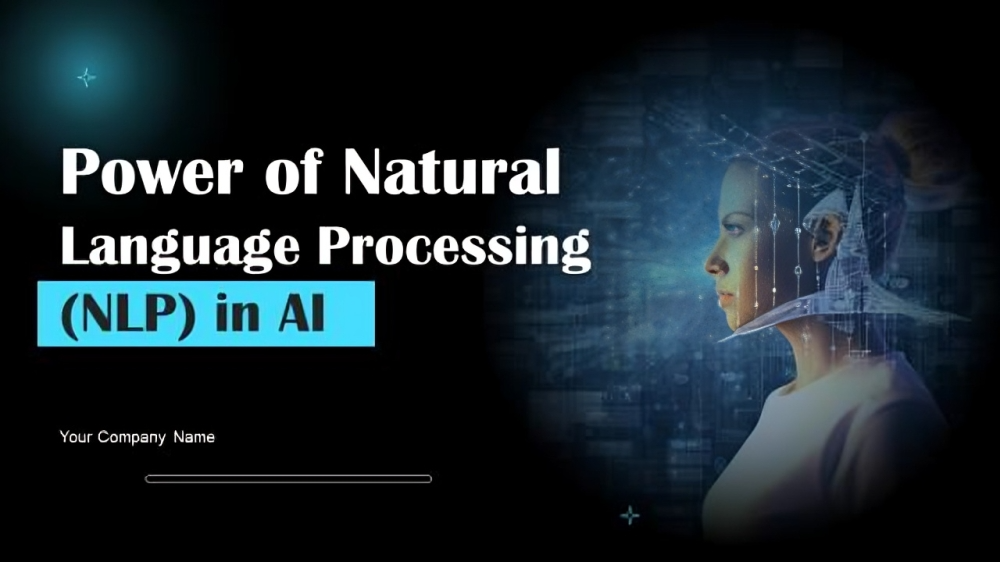Tech
Unlocking the Power of natural language processing ppt

You have entered the intriguing realm of Natural Language Processing (NLP), where computers are taught to comprehend and interpret human language in a nearly natural manner. This article will explore the potential of natural language processing (NLP) and how it is changing the face of technological interaction. Hold on tight because we’re about to unleash the power of natural language processing (NLP) with an in-depth PowerPoint presentation that will blow your mind with the results of combining language and technology.
Understanding the Basics of NLP
One interesting area of study is natural language processing, or NLP. This area studies how computers and humans communicate through language. We may uncover NLP’s amazing powers in numerous applications by knowing its foundations.
Natural language processing (NLP) has its roots in the 1950s, when scientists first started to investigate how computers might mimic human speech. Machine translation, sentiment analysis, and chatbots have all benefited from natural language processing’s steady evolution.
Among the many uses for natural language processing are voice recognition systems such as Alexa and Siri as well as email filtering and spam detection. In order to effectively handle massive volumes of language data, these systems depend on intricate algorithms.
Natural language processing systems are able to evaluate sentence structures utilizing morphological, syntactic, semantic, and pragmatic analyses because they tokenize text, which breaks it down into smaller parts called tokens. The precision with which robots can understand human language is improving because of this multi-stage procedure.
Definition and History of NLP
An intriguing area of study, Natural Language Processing (NLP) analyzes how computers and humans communicate through language. It entails instructing computers to comprehend, decipher, and produce meaningful and practical human language.
Researchers in the 1950s started looking for ways to make computers understand and react to real language; this is when natural language processing (NLP) got its start. The capabilities of natural language processing systems have been substantially improved over the years due to developments in both technology and algorithms.
Many other sectors have begun to use NLP, including healthcare, banking, customer service, and many more. Natural language processing (NLP) is changing the way people engage with technology in several ways, such as chatbots that offer immediate customer service and sentiment analysis tools for social media monitoring.
There is no end to the ways natural language processing (NLP) may revolutionise businesses and improve user experiences as it adapts to new machine learning techniques and deep learning models.
Applications of NLP
Many different sectors can benefit from natural language processing. Notably, NLP excels in the domain of customer service. Overall customer happiness may be enhanced when companies analyze customer interactions to have a better understanding of feedback and mood.
When it comes to healthcare, natural language processing (NLP) is indispensable for mining academic journals and patient records for actionable insights. This paves the way for better patient diagnostics and more tailored treatment programmes.
Natural language processing (NLP) is likewise transforming the banking sector by mechanizing processes such as risk assessment and fraud detection. Financial organizations may make educated judgments to successfully manage risks by processing enormous amounts of data fast and correctly.
Also, natural language processing (NLP) is useful in advertising and marketing since it allows businesses to study customer behavior patterns and create more personalized ads that really hit home with their target demographic. As technology progresses, the range of applications for natural language processing (NLP) grows, spurring innovation in several industries.
How Does NLP Work?
Interactions between computers and human language make up the intriguing domain of Natural Language Processing (NLP). However, the magic of NLP is not immediately apparent.
Tokenization is the first step in the process. It involves breaking down the text into smaller parts, such words or phrases. Additional analysis can be built upon this base.
A word’s morphology—its root and affixes—is the primary subject of morphological study. Analyzing the laws of syntax reveals how words fit together to make sentences and phrases.
Now we may go on to semantic analysis, the next step in deciphering the meaning of words and phrases by looking at them in context. The larger ramifications of language use in actual contexts are then examined through pragmatic analysis.
Through the smooth execution of these procedures, natural language processing (NLP) empowers robots to understand and produce human language—an astounding achievement with boundless potential!
– Steps in NLP: Tokenization, Morphological Analysis, Syntax Analysis, Semantic Analysis, Pragmatic Analysis
Has the inner workings of Natural Language Processing (NLP) ever piqued your interest? Let’s explore the intricate procedure by delving into its intriguing phases.
To begin, there is tokenization. Tokenization is the process of reducing large pieces of text to smaller ones; these units can be anything from words to entire sentences. By providing a framework for the text data, tokenization prepares it for additional analysis.
After that, natural language processing moves on to morphological analysis, which is all about looking within words to figure out their grammatical components and root forms. A better grasp of the language is achieved by being able to recognise various word forms and variants.
Next, natural language processing (NLP) examines the sentence’s grammar to determine the words’ connections and meanings in context. The laws of grammar that regulate the usage of language may be understood through the use of syntax.
The next step is semantic analysis, which looks for patterns in the text to determine what the author meant by analyzing ideas, entities, and word relationships. Understanding the meaning of the words used is the goal of this stage.
Stepping things up a notch, pragmatic analysis provides an interpretation of language that is grounded on practical knowledge and context. It uses aspects such as cultural subtleties, tone, and purpose to deduce deeper meanings from texts.
These processes help us understand how natural language processing (NLP) works to understand human language better.
Tools and Techniques Used in NLP
Natural Language Processing (NLP) is a powerful tool for analyzing and comprehending human language. It employs a variety of methodologies and technologies. To enable computers to discover patterns and generate predictions from data, NLP relies on machine learning methods.
Another important part of natural language processing (NLP) is statistical approaches, which allow computers to efficiently handle massive volumes of text data. Natural language processing systems are able to glean useful information from unstructured text by employing statistical models.
By teaching computers to grasp linguistic subtleties and context, deep learning models have utterly transformed natural language processing. Improved sentiment analysis, translation, and chatbot interactions are made possible by these intricate neural networks.
New opportunities for applications across industries including healthcare, banking, customer service, and more are being opened up by the rapid evolution of NLP tools and approaches.
Machine Learning Algorithms
Natural Language Processing (NLP) relies heavily on Machine Learning Algorithms, which allow computers to learn from data and make judgements without being explicitly programmed. These algorithms enable natural language processing systems to analyze and comprehend patterns in human speech.
The Naive Bayes classifier is a well-liked machine learning method in natural language processing (NLP). It is useful for text classification applications such as sentiment analysis and spam detection. Support Vector Machines (SVM) are another popular algorithm because of its famed capacity to manage intricate data connections.
Machines can now understand complex language patterns because of deep learning models like CNNs and RNNs, which have transformed natural language processing. Machine translation, voice recognition, and NLG are just a few of the areas where these models really shine.
Improved human-machine communication is possible with the integration of several machine learning algorithms into natural language processing (NLP) pipelines, which allow computers to derive valuable insights from massive volumes of textual data.
Statistical Methods
When it comes to processing natural language, statistical approaches are crucial. In order to get useful conclusions from text, these methods analyze and interpret data. Experts in natural language processing (NLP) use statistical models to extract meaningful information from language datasets.
The use of probabilistic modeling is widespread in natural language processing (NLP). Assigning probability to various language events, such word sequences or syntactic structures, is the essence of this technique. Natural language processing systems are able to produce more precise forecasts on language use by computing these probability.
In natural language processing, sentiment analysis is another crucial statistical tool. Emotions conveyed in text data are quantified and classified using this approach. Businesses may benefit from sentiment analysis by better understanding consumer attitudes and comments through the application of statistical techniques.
Natural language processing applications rely heavily on statistical approaches to glean useful information from textual input.
Deep Learning Models
Natural language processing (NLP) relies heavily on deep learning models, which allow computers to learn and get better over time without human intervention. To decipher intricate correlations and patterns in linguistic data, these models imitate the way the human brain handles information.
Without the need for human intervention, deep learning models can automatically extract characteristics from raw data, which is a major benefit. As a consequence, activities related to language processing, including machine translation, sentiment analysis, and text categorization, become more precise and efficient.
When it comes to natural language processing (NLP), a lot of people employ CNNs, RNNs, and transformer models like BERT and GPT-3. Chatbots, speech recognition systems, and automatic summarization tools are just a few examples of how these designs have improved machine understanding of human languages.
With the help of deep learning techniques, natural language processing (NLP) is pushing the envelope when it comes to recognising subtleties of human language, which opens the door to more complex machine-human communication.
Real-world Examples and Use Cases of NLP
Natural Language Processing (NLP) Use Cases and Examples in the Real World highlight the many ways this robust technology is put to use. Natural language processing (NLP) is causing a stir in a number of sectors, from social media sentiment analysis to customer support chatbots. Tech giants are embracing natural language processing (NLP) to improve user experience, automate processes, and mine massive volumes of text data for insights.
Natural language processing appears to have endless promise as it keeps becoming better and more advanced. Organisations and individuals may maintain a leading edge in language understanding and communication by harnessing the potential of natural language processing (NLP) through in-depth PowerPoint presentations and other instructional materials. More effective procedures, better decisions, better customer interactions, and overall company success are all within reach when NLP is used.
One way to take advantage of the digital age’s limitless development potential is to integrate natural language processing (NLP) into your workflow. In order to fully use natural language processing ppt presentations for your business or personal projects, stay up-to-date with the newest advancements in the field. Dedicate yourself to self-improvement by delving into the boundless potential of NLP.
-

 News10 months ago
News10 months agoTrump Mug Shot: Exploring the Controversy, Legal Aspects, and FAQs
-

 Tech9 months ago
Tech9 months agoGuide to Nextdoorstudios: Your Ultimate Resource
-

 Health4 months ago
Health4 months agoThe Health Benefits of Indica Edibles: More Than Just a High
-

 Tech4 months ago
Tech4 months agoShine Bright with the Twice Lightstick
-

 Health5 months ago
Health5 months agoThe Best Hybrid Marijuana Strains for a Balanced and Customizable High
-

 Home and Garden10 months ago
Home and Garden10 months agoExploring the World of Spelling Bee Forums: Your Ultimate Guide
-

 Entertainment9 months ago
Entertainment9 months agoIzanami Backwards: Unveiling the Mysteries
-

 Fashion6 months ago
Fashion6 months agoThe Timeless Comfort- Exploring the Essentials of Tracksuit
















